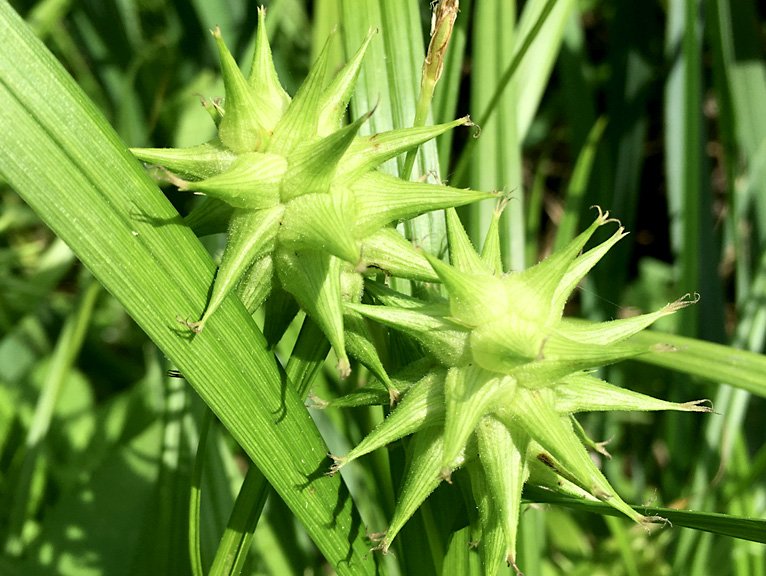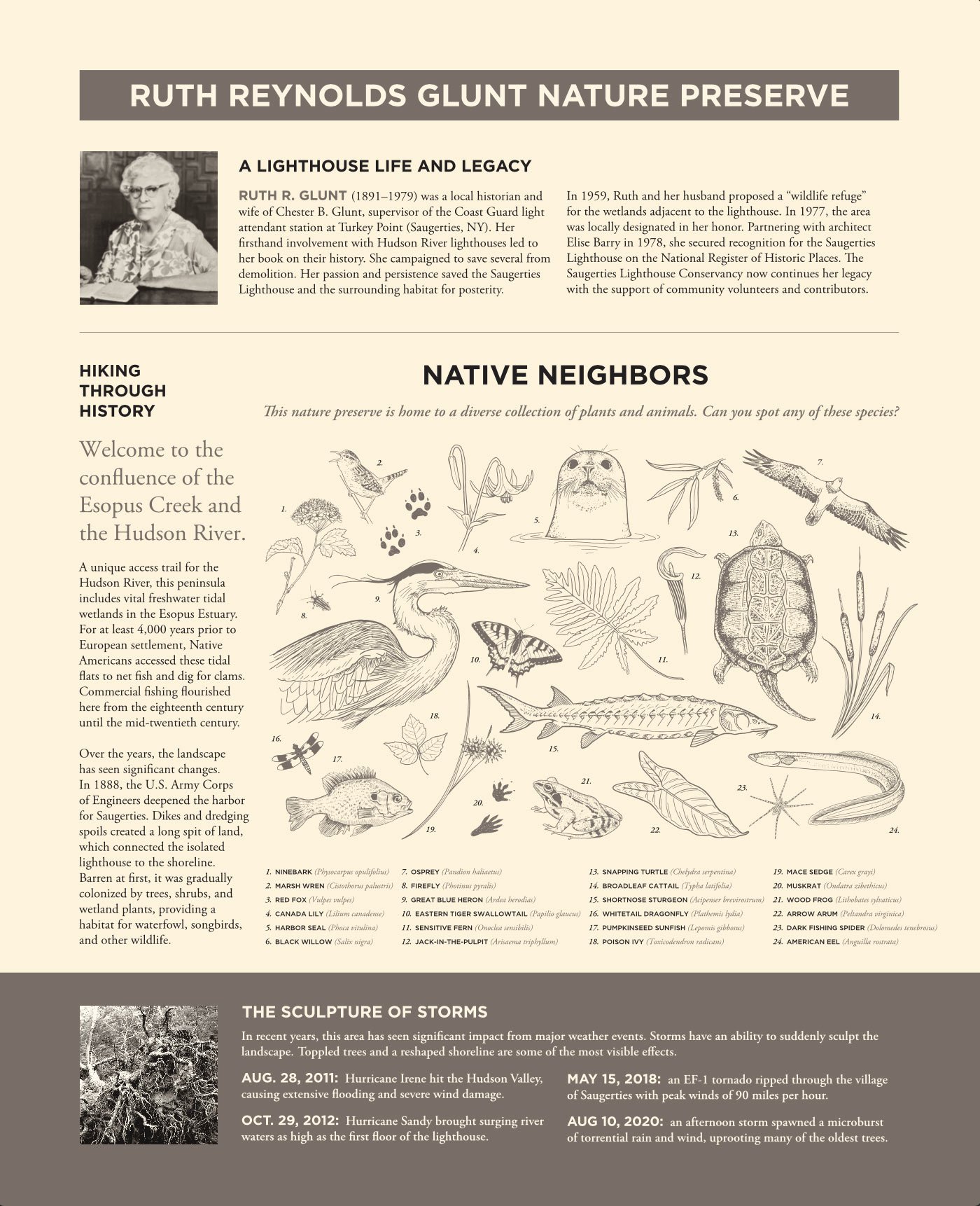Ruth Reynolds Glunt Nature Preserve
A LIGHTHOUSE LIFE AND LEGACY
Ruth R. Glunt (1891–1979) was a local historian and wife of Chester B. Glunt, supervisor of the Coast Guard light attendant station at Turkey Point (Saugerties, NY). Her firsthand involvement with Hudson River lighthouses led to her book on their history. She campaigned to save several from demolition. Her passion and persistence saved the Saugerties Lighthouse and the surrounding habitat for posterity.
In 1959, Ruth and her husband proposed a “wildlife refuge” for the wetlands adjacent to the lighthouse. In 1977, the area was locally designated in her honor. Partnering with architect Elise Barry in 1978, she secured recognition for the Saugerties Lighthouse on the National Register of Historic Places. The Saugerties Lighthouse Conservancy now continues her legacy with the support of community volunteers and contributors.
See hours, directions, and guidance on trail use
Check the Tide Table
before you arrive
Volunteer as a Trail Steward
during the summer
Hiking through History
WELCOME TO THE CONFLUENCE OF THE ESOPUS CREEK AND THE HUDSON RIVER
A unique access trail for the Hudson River, this peninsula includes vital freshwater tidal wetlands in the Esopus Estuary. For at least 4,000 years prior to European settlement, Native Americans accessed these tidal flats to net fish and dig for clams. Commercial fishing flourished here from the eighteenth century until the mid-twentieth century.
Over the years, the landscape has seen significant changes. In 1888, the U.S. Army Corps of Engineers deepened the harbor for Saugerties. Dikes and dredging spoils created a long spit of land, which connected the isolated lighthouse to the shoreline. Barren at first, it was gradually colonized by trees, shrubs, and wetland plants, providing a habitat for waterfowl, songbirds, and other wildlife.
Trail Kiosk
Day Visits
OPEN DAILY, SUNRISE TO SUNSET. Parts of the trail experience tidal flooding on a twice-daily basis, so come prepared or plan accordingly. Consult the tide table for more details. The half-mile trail traverses 15 acres of freshwater tidal wetland habitat in a remote, undeveloped area of the Esopus Estuary, among stands of willow and maple trees, along tidal pools, and through patches of wildflowers, eventually opening onto the middle of the majestic Hudson River at the lighthouse. In winter, you may encounter ice or snow on the trail, so wear appropriate footwear. Icy walkways in winter; ice traction devices highly recommended.
Leave No Trace
Please help us keep the area beautiful and safe.
PLAN AHEAD AND PREPARE. Check forecasts before you depart. Wear appropriate clothing and footwear.
STAY ON TRAILS. Do not trample vegetation or disturb habitat.
CARRY OUT WHAT YOU CARRRY IN. Do not litter.
LEAVE WHAT YOU FIND. Do not pick flowers. No graffiti or carving. Leave natural objects and artifacts.
RESPECT WILDLIFE. Do not touch, harass, or feed wildlife.
BE CONSIDERATE. No large groups or tour buses. Please respect the privacy of the resident Lighthouse Keeper and overnight guests.
Standard Use
Use of this area is at your own risk.
A person entering the premises assumes the risks of use pursuant to New York Consolidated Laws, General Obligations Law GOB § 9-103 (Recreational Use Statute).
Limited Hours
Public use may be restricted or closed for special events, repairs, or other reasons without prior notice.
Permitted Activities
This area is reserved for hiking and fishing. All other activities are prohibited or require permission.
Dogs
Dogs must be kept on leash. Pick up and remove all dog waste.
Restroom Facilities
Outdoor portable toilets are available for public use at the trailhead and lighthouse dock.
Special Use
Commercial Activity
Prior written permission is required for any commercial activity on the premises, including but not limited to photo shoots, filming, tours or charters. For details, please email the Lighthouse or call 845-247-0656.
Groups and Events
Prior arrangements required for special events, large groups (in excess of eight), or exclusive use of the deck area.
More about our surrounding environment
Located along the Hudson River at the confluence of the Espous Creek, the land surrounding the trail to the Lighthouse consists of 17 acres of wooded grounds and tidal wetland flats. The area is supported by a sandbar comprised of dredged sediments from the channelization projects of 1888 and 1889, at which point the Esopus Creek was deepened to make way for ship access to the Saugerties Harbor.
The resulting peninsula now offers a scenic half-mile trail to the Lighthouse and its surrounding public decks, as well as a forked trail to a beachside picnic area on the Hudson. Family-friendly and easily accessible by car or foot, the trail serves as an enjoyable hike for kids and a preferred spot for bird watching, boat spotting and admiring the changes of the seasons. Traversed directly, the trail to the Lighthouse is only about a 10-minute walk across earthen stretches, sandy flats and wooden boardwalks. It’s important to note that the peninsula is subject to tidal flooding, making portions of the trail impassable at certain times of day. Please always check the tide table before your visit so you’re prepared for what lies ahead. You’ll also find a tide table posted in the kiosk located at the entrance to the trail. Waterproof, seasonal footwear is strongly recommended.
Home to nearly 100 species of flora, the trail’s unique plant life includes trees, shrubs, vines, herbs, sedges, grasses and ferns. Over the years, the area has seen an increase in exotic invasive species such as tall Phragmites reeds and the Eurasian water chestnut, colloquially known as devil’s heads or cow heads. Growing in presence along eastern waterways, the water chestnut blooms restrict light and cut off oxygen to the surrounding waters, making it difficult for native plants and fish to share the same space. The area also hosts the Purple Loosestrife perennial weed, one of the most invasive non-native species in North American wetlands. While offering a beautiful splash of color to the landscape, the shrub is prolific in its spread and tends to push out the opportunity for native plants to flourish. This shrub is thought to have been accidentally introduced by the shipping industry, as often rocky soil dredged from European wetlands was carried in ships to help maintain balance during long, rough voyages across the ocean. Upon arrival, the seed-rich soil was released into the coastal waters.
The peninsula is also an important habitat for breeding and migrating birdlife. Keep an eye out for nesting bald eagles, great blue herons, gulls, geese, ducks and hundreds more.






















